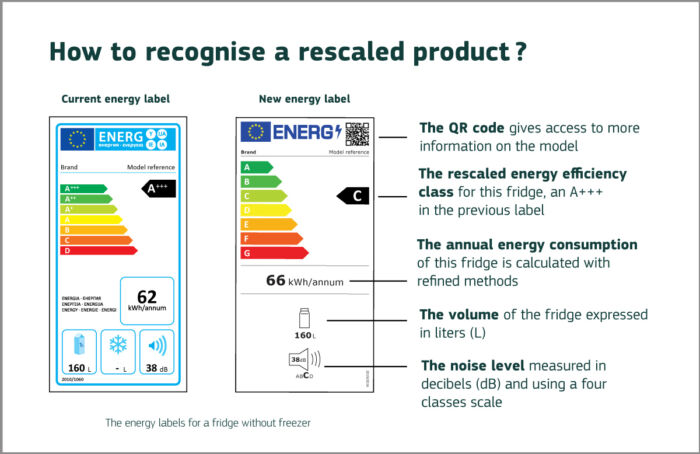
By using less energy to perform the same task, we can make significant energy savings and reduce waste. This is the basic principle of energy efficiency, and it is one of the most essential ways for the EU to move away from fossil fuels and achieve carbon neutrality by 2050.
Improving energy efficiency will benefit society by reducing emissions and our dependency on energy imports, while also lowering energy costs for citizens and businesses across the EU.
The EU energy label
The EU energy label is – together with minimum “ecodesign” requirements – a success story that has been key in boosting the energy efficiency of everyday electric appliances like lighting, heating, fridges, freezers and televisions, but also products like fuel boilers, tyres and air conditioners.
Since its inception in 1994, EU energy labels have helped steer and guide consumers to choose products that use less energy and therefore, over the products life span, also cost less.
The energy label is recognised by 93% of consumers and 79% consider it when they are buying new electric appliances, according to Special Eurobarometer 492. It has been a source of inspiration both for similar labels for buildings, cars and food produce and for lawmakers, also outside the EU.
Back to the original scale A to G
The success of the EU energy labels has meant that manufacturers have continued to innovate and develop more and more energy efficient products. For some product categories the “A” was no longer enough to describe the most energy efficient products, so the A+, A++ or even A+++ had to be added to the classification system. At the same time, the lower classes (E, F, G) for some product categories were phased out due to ecodesign requirements or became so rare that they were no longer needed.
To help consumers make informed choices when they buy new energy efficient products and at the same time continue encouraging industry to develop less energy-consuming products, it became clear that the EU energy labels needed a simpler scaling system.

The EU energy labelling framework regulation was updated and adopted three years ago (Regulation (EU) 2017/1369) and will reintroduce a simpler classification, using only the letters from A to G. The rescaling will also lead to better differentiation among products that, under the current label classification, all appear in the same top categories. It means, for example, that a fridge that currently has the A+++ label could become a C category, even though the fridge is just as energy efficient as before, or that an A++ dishwasher could become an E category. The main principle is that the A category will be empty at first, and B and C categories scarcely populated, to pave way for new, more energy efficient products to be invented and developed.
The European Commission announced in March 2019 that the first set of new energy labels for dishwashers, washing machines, refrigerators, and electronic displays will be visible in shops as of 1st March 2021 and for lamps, as of 1st September 2021. In practice, this means that labels for these product groups will be rescaled from March or September 2021 onwards and that old labels will be replaced after a short transition period of 2 weeks. There can be some rare exceptions, like when a product model is discontinued. In that case, the model that is already on shelves in the shop can keep its old label.
What will change – and how to read the new label?
EU consumers can expect significant energy savings from the rescaling of labels, but industry professionals, like system designers and installers, will also benefit from clearer guidance.
- The new labels will contain a simpler scale (A to G) and it will be easier to compare the energy efficiency between different products.
- The EU energy label is language neutral, a must as there are 24 official languages within the EU internal market.
- By scanning a QR code in the upper right corner, consumers will have access to more detailed product information in the European Product Registry for Energy Labelling, called EPREL. This database will be accessible to the public at the end of 2020. The EPREL database will help national market surveillance authorities to verify that the products comply with requirements on energy efficiency and that the information on the label is correct.
- The new labels can also feature icons that show information like product capacity or dimensions, noise level or water consumption, providing at a glance useful information to the consumers.
Innovation and product development of even more energy efficient, sustainable products continue, and further rescaling will be necessary also in the future, when the A and B categories become largely populated.



































